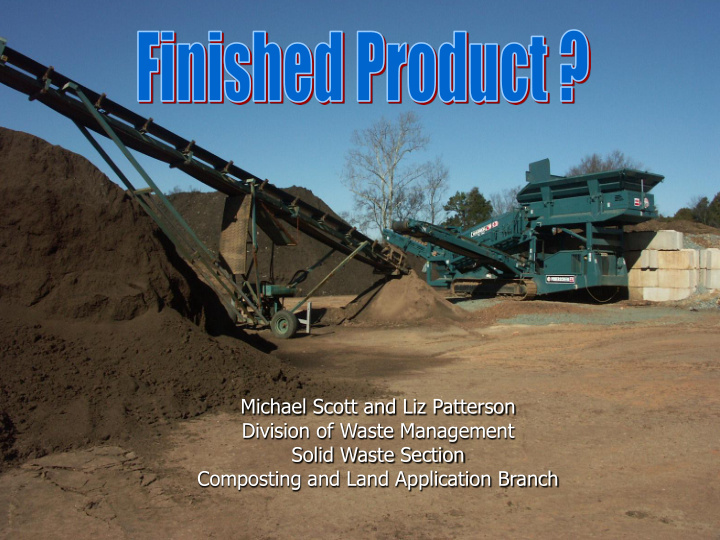



Michael Scott and Liz Patterson Division of Waste Management Solid Waste Section Composting and Land Application Branch
► How should we define finished product? ► What impact does that have on the process?
The current solid waste regulations classify finished product based on the Federal standards for: pathogens, heavy metals, foreign matter and total N. APS sites? Type I facilities?
► Is a finished product that satisfies the State and Federal requirements suitable for all end uses? ► How do we further define finished product? ► 15 days at or above 131 F ?
► Stability: Degree of stabilization of the organic substances in compost (inversely related to the microbial activity and the bioavailability of organic matter).
► Maturity: Degree of decomposition of phytotoxic substances and the adequacy of compost for plant growth (includes the absence of other toxic components like excessive metal concentrations or high salinity).
► Stability measured by: Biological indicators of microbial activity (respiration)
► Maturity evaluated by: Plant assays
► Defining finished product: What impact does that have on the process? Stormwater or wastewater?
How do other states address finished product?
Compost maturity tests can be used for: ► Evaluating compost progress and using the information to make improvements to the composting process ► Determining the level of maturity of any compost product intended for use or marketing and using the information to make informed recommendations about its best use
Solvita CO 2 Test
INTERPRETING SOLVITA CO 2 TEST RESULTS SOLIVITA TEST RESULTS APPROXIMATE STAGE OF MAJOR CLASS THE COMPOSTING PROCESS Highly matured compost ; well aged; possibly over-aged; FINISHED 8 Like soil; ready for most uses COMPOST Well-matured, aged composts; cured; FINISHED 7 Ready for most uses COMPOST Aeration needs are reduced; curing; ACTIVE 6 Significantly reduced management requirement COMPOST Compost is moving past the active phase of decomposition; ACTIVE 5 Ready for curing; reduced need for intensive management COMPOST Compost in medium or moderately active stage of ACTIVE 4 Decomposition; may be ready for curing COMPOST Active compost; young materials, high respiration rate; ACTIVE 3 Still needs intensive oversight and management COMPOST Very active, moderately fresh compost; very high RAW 2 Respiration rate; needs very intensive aeration COMPOST And/or turning Fresh, raw compost; typical of new mixes; extremely high RAW 1 Rate of decomposition; very putrescible or odorous materials; high in volatile organic acids COMPOST
Solvita Ammonia Test
Recommend
More recommend